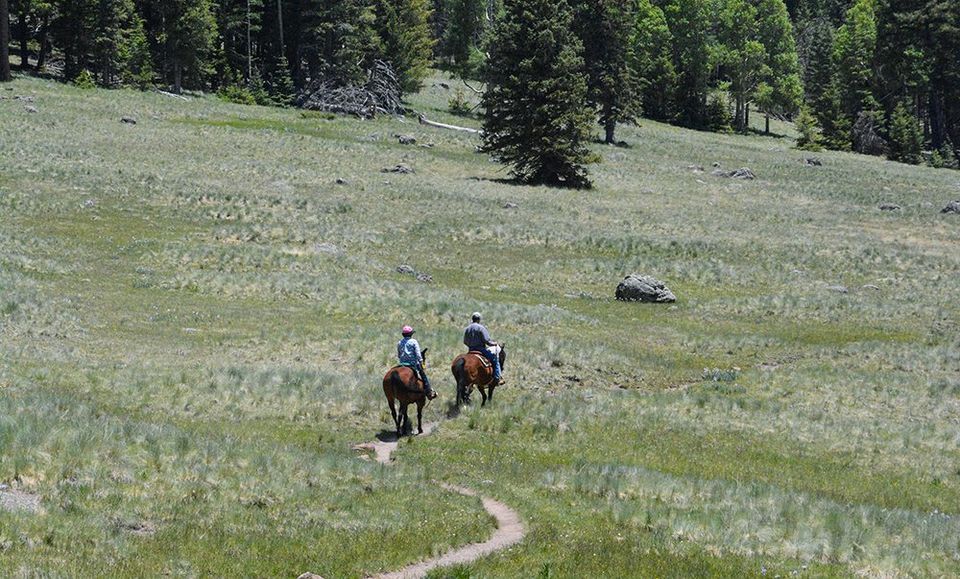
As spring winds and warmer temperatures dry out the White Mountains, hikers, equestrians and bicyclists eagerly return to the trails that have been too muddy to use during the winter. Everyone wants to have a safe, relaxing, enjoyable trail experience yet we all have to share the trail with other users. The White Mountain Trail System is non-motorized and has a trail sharing protocol that is quite simple: bicyclists yield to horses and hikers yield to both bicyclists and horses. This hierarchy for trail sharing was the result of careful research and discussion of the safest way for these users to interact on the trails based on the relative speeds, maneuverability and predictability -- or lack thereof -- of the various trail users. The US Forest Service requires that all dogs be kept on a leash. All trail users are expected to always be safe, respectful and courteous toward all other trail users.
The White Mountains are volcanic in origin and much of the soil in the region is clay that becomes mud soup when wet, then dries almost as hard as concrete within a matter of days. Every shoe, hoof and bicycle tire that crosses the mud dries into an ankle–twisting, wheel turning hole or rut that stays in the trail until it is either pounded down by more trail users or the next spell of wet weather turns the clay into soup again. This is why T.R.A.C.K.S. and the US Forest Service would prefer everyone stay out of the Forest when it is muddy.
Everyone yields to horses because even the best trained horses ridden by skillful riders can still be unpredictable. Horses are prey animals so they instinctively fear sudden movements, strange noises, bright colors, odd shapes and anything they cannot identify. Horses prefer to run away from danger so horses are seldom aggressive. However, if a strange dog suddenly comes up behind a horse’s heels, even the best trained horse may kick in self-defense before its rider realizes a dog is present. Well-trained, experienced trail horses learn to safely cope with whatever they encounter on the trail. However, horses can only develop experience on trails by being ridden on trails. You cannot tell by appearances how much training a particular horse has so the trail sharing protocol assumes that horses are unpredictable. For everyone’s safety, people and dogs need to stay at least 10 feet away from horses, step off the trail, stand still and refrain from making sudden moves or loud noises until the horse or horses are well past you. Do exchange pleasant greetings with the rider(s). The conversation will help the horse(s) identify what you are. Do not touch a horse or feed it anything unless you have specific permission to do so from the rider or handler.
Bicycles are the fastest trail users so bicyclists have an extra responsibility to be alert to the presence of other trail users and slow down or stop far enough away to avoid conflicts. When everyone is polite and respectful, safe exceptions to the trail sharing protocol can be negotiated on the spot -- on a case-by-case basis among the individual trail users involved, such as a bicyclist and an equestrian agreeing on where and how the bicyclist can safely pass that particular horse that one time.
Safety is the reason the Forest Service requires that dogs be kept on a leash. Far too often, loose dogs harass and injure wildlife, horses, hikers and bicyclists. Coyotes, cougars and other wild animals are hostile to stray dogs in their territory. Staying on leash is important for the dog’s own safety, as attested by the sad signs about lost dogs that too often appear on White Mountain Trail System kiosks. For everyone’s welfare and enjoyment, always keep dogs fully controlled.
The White Mountain Trail System is open to cross country skiing and snow shoeing, when the weather permits, as indicated in the T.R.A.C.K.S. name. Be aware that the trail tread is invisible under snow and white trail markers can be difficult to see against the snow-covered trees. Keep in mind that hikers and horses may also be using the trails in the snow. Traveling in snow is hard work so be prepared to stay warm -- but not wet -- and hydrated.
Last but not least, don’t litter! Be careful to pack out everything you carried with you into the Forest and dispose of it properly. Please make a habit of following trail etiquette and treat all other trail users with the courtesy and respect you want them to give you. Enjoy your hike or ride!











